#don't know how historically accurate it is
Text

Five minutes before they declare war on each other
#Otto loves his bratty gf that constantly causes him trouble#hetalia#hws italy#aph italy#hws veneziano#aph veneziano#hws north italy#aph north italy#No it's not Nyo Italy (/._.)/#hws hre#aph hre#hws holy roman empire#aph holy roman empire#holitalia#I can't draw historical accurate Renaissance male clothes#they are so silly and I don't know how to be professional about that#holytalia#my art
39 notes
·
View notes
Text
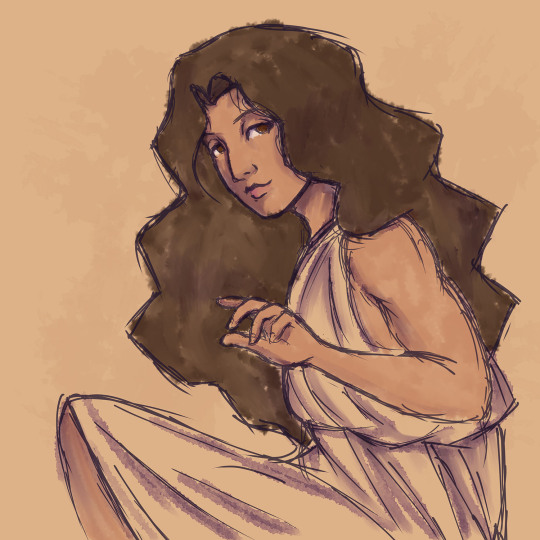
Here’s a sketch of my problematic fave or Aphrodite’s poor little meow meow. Paris of Troy.
#the iliad#greek mythology#paris of troy#the trojan war#Been thinking a lot about the Iliad recently#I'm thinking of drawing how I imagine the different characters of the Iliad because. Why not? Everyone is doing it#I also love drawing men with long curly hair. Can you blame me?#Also. That outfit is not historically accurate I know. I just don't care is a quick sketch lmao
78 notes
·
View notes
Photo
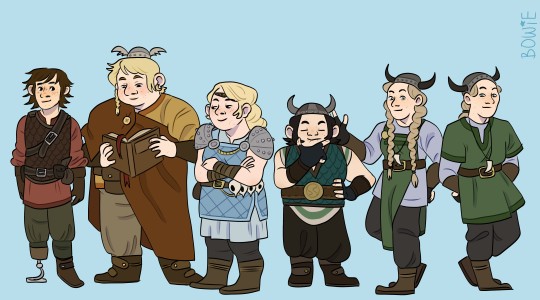

dragon rider outfit designs based on historical re-enactment photos, plus some extra Astrids because i love her <3
#i don't want to say they're historically accurate because i don't know that much about viking fashion#but they are inspired by actual research i did so#my art#httyd race to the edge#how to train your dragon#astrid hofferson#hiccup haddock#fishlegs ingerman#snoutlout jorgenson#tuffnut thorston#ruffnut thorston#redesign#digital art
326 notes
·
View notes
Photo
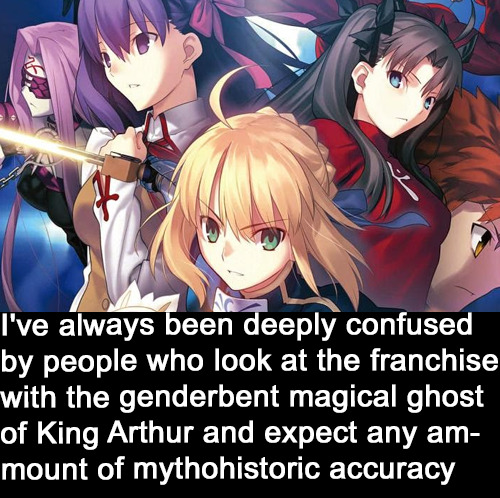
#saw a good tweet about this today actually#about how like#there's a difference between fate stay night making artoria a girl#which ties into her backstory and is explored in an interesting way#and ultimately just adds another layer to the king arthur myth#compared to now in fgo making the 300th waifuified skimpily dressed historical figure#fate (when it's good) is yeah not accurate#but it keeps the spirit of the myth#creating its own myth by weaving together various interpretations and new ideas#babbage being a robot is not 'historically accurate' but it makes sense because he was one of the inventors of computers#vs (as the tweet i saw mentioned) making zenobia into a lazy fanservice design while taking away her agency and making her masochist#erases the meaning of her story completely#perverting it really#i think honestly complaining ABOUT people complaining about how fate handles characters#is honestly selling the series you like short#the people who are complaining are doing it BECAUSE they know fate can be good#and make really good interesting characters and interpret history well#and if you don't get that then you're underestimating fate's ability to be good#and treating it as just another shitty waifu game when it's way more than that#ok rant over sorry#sfw#fandom criticism#fate series criticism
305 notes
·
View notes
Text
TF2 fanfic writers know they can just write Demoman, right? Like they know don't have to shoe-horn in a plot point about him being oppressed for his race just to quickly say: "Hey guys racism is bad", right?
Like, honestly it's more racist to take the only black character and boil them down to a stepping stool for the author to stand on and preach about how bad racism is.
#Breaking news: local fanfic author destroys racism by having the characters in their Boots N' Bombs fic punch a racist#I'm pretty sure everyone and their mother knows about how the 60s were for people of colour#You don't need to have a character tossing slurs to make your story “historically accurate”#tf2#team fortress 2#demoman tf2#I REALLY wanna write about this silly guy sometime soon and it sucks how much fanfic is like this#Why can't he be goofy like the rest of them why is he stuck with this role?#sp-rambles
26 notes
·
View notes
Text
Okay but my question is: if no one has been outside of the walls since they were built, how does everyone know all the different types of animals Nimona turns into??
#surely they don't have all of those animals within the walls#unless they only have them in captivity#but I don't know how viable it would be to have animals only in captivity for 1000 years without massive amounts of inbreeding#they also could just have historical records of the animals#but we know that the records they keep aren't the most historically accurate#GOD must I overthink everything??????????#nimona
12 notes
·
View notes
Text
YOU KNOWWW i think. people need to be more comfortable with just not liking things and using their big grown up words. like you can have serious real world reasons to hate a piece of media whether it be in content or the creator or even just the annoying fanbase or that it's currently popular and therefore Everywhere but the way people go about this entire thing as a whole is just so fucking weird to me atp
like the whole thing with "irredeemable media" is insane even if i and i would say most of us agree there ARE things you can't be a fan of without either embracing or dismissing real world bigotry and enacting harm but jesus christ man sometimes you can just tell people are treating their little tumblr mutuals circles as a Perfect pure circle of untouched perfect media and then the kicker is half of the shit that circle are into is equally as ~Problematic~ as whatever it is they're blocking people over ...
like curate ur online space or whatever but can you at least self reflect a little or something and realise it isn't a morality race of who gets into heaven first for posting about something on fucking tumblr. i have no idea how people actually care this much about something to be honest. people will also defend nonstop their own right to the "critical consumption" of something but then literally flatline the inability to process maybe other people do that too as well...
like practically everything made on earth has flaws and valid criticisms that should be addressed and not ignored + people have different levels of tolerance and intolerance to something that isn't more or less valid than someone else's bc we all have different lived experiences and are in fact unique individuals + there is no such thing as a pure piece of media that only good people like. and i find it deeply stupid to encourage this but never actually apply it ?? like being critical of something has somehow just turned into "everyone who likes this is now x and y/happily supports x and y and because i've said that i'm now a good person" and it's literally just tumblr.com/dashboard the whole time 😭 anyway like once again i literally have severe ocd and the autism morality and even i'm not as black and white as some of the ppl on this site that's crazy...
#🐾#this could apply to literallt so much which is the entire point but like i don't know#like a lot of the things i like have glaring flaws some more prominent than others#and some more EXAGGERATED than others ...#and i do have a threshold for what i consider acceptable to continue being a fan of smth for but man. it's crazy#and even then i'm not a fucking loser and if someone posts about it i'm not going to banish them to hell for it bc it doesn't matter#unless it's smth particularly bad but like ykwim#LIKE OKAY wrt our flag the criticism of using actual historical figures is like obviously perfectly normal to have#but it's also like. that criticism applies to all ''pirate'' media and is not unique to our flag#but what is unique to it is it's not even a historically accurate show like come on they say ''lol'' and half of them wear modern clothes😭#there's people that exist that didn't exist irl for like a hundred years it's a stupid comedy using a baseline#and i DO think it's still a valid criticism bc yeah it's true they could've used it as inspo and made their own characters#but like. they did anyway. it's a fantasy ahistorical retelling that the creator acknowledges is nothing like the real world counterparts#and the creator also CONDEMNS the real life counterparts and the actors don't even know anything about them#and with that i think the only issue is the continuation of acting like those men were good people and shit like those idiots who left#flowers on one of their graves bc of the show. ridiculous shit#and i also know the nature and history of woobification and how it affects this i just don't think it's really the case Tbh#also end of the day like 90% of the people who hate it so just hate it for being annoying so just like fucking say that don't be a pussy#also i'm not being condescending when i say the different tolerances thing like#i think anyone can have entirely reasonable reasons to hate something and honour hating it and such#but then i think acting like everyone on earth cannot possibly hold space for that whilst continuing to be a fan and respectfully being#actually in the literal sense Critical as in Having criticism then it tends to snowball#like no one has to be comfortable with anything it's literally fine
4 notes
·
View notes
Text
Oh it's so over for You I've started finally working on my Good Omens fic again You can't stop me now
#v1nsincl4ir#good omens#thoughts#it's this fic where all the angels and demons are instead scottish mythos set in the highlands during the late 1500s-early 1600s#crowley is a kelpie and aziraphale is an urisk#and all of the locations are real#albiet i have little way of knowing how historically accurate some parts will be because i do not know what the area looked like in 1600#unfortunately#do you have any idea how hard it is to find historically accurate information on random scottish villages' histories online?#do you have any idea how hard it is to find ANY information on random scottish villages' histories online?#do you have any idea how hard it is to find information on random scottish villages FULL STOP?#because it's very fucking hard#but noooooo i had to have a very specific niche in my reawoken mythology interest that i've decided to turn into a whole good omens fic#and i was like oh i don't want to make up a “fantasy scotland” or something i know i'm not gonna be able to make the names sound right#because no matter how well you think you can create a fake scottish place name it is never going to sound quite right#or maybe that's just my perfectionism#and you know the wildest part is that i know the name of every place they visit but for half of the locations the readers WON'T know that#because both of them have no fucking clue where they are for half the story#but I DO#okay#I DO
3 notes
·
View notes
Text
Just came back from watching Napoleon and ugh.
#napoleon#look it started bad and ended badly#i'm on record defending that historical movies don't need to be perfectly accurate but this movie was just...ugh#like just the casting...why in hell is Phoenix playing 20s Napoleon? also my mom asked me if Napoleon died in his 30s which...#it's mostly the casting's fault#ei guys lack of Wellington in this movie. and lack of Portugal's Napoleonic invasion's too#this said i understand why...they happened during the time he was planning the invasion of Russia...but important ok!!#it was not a nice movie no.#weird points for the fact they did not even got the most stereotypical Egyptian fact right. THEY MUMIFIED THEIR DEAD!!#also why in hell did he shot the pyramids? who knows? was it a cool scene? maybe for someone who did not have any idea of anything.#my mom telling me that physically ice doesn't break like that in the scene of the battle of Austerlitz#for some reason they butchered Napoleon's entire relationship with Josephine. also weirdo#there was almost nothing good there#points for how good the customs were. making it easy to distinguish armies in a battlefield is not an easy task
3 notes
·
View notes
Text
How to make a 210-year-old evening gown
Step 1: Find an inspiration gown with woefully few reference photos and no photos of the back.
Step 2: Decide that you want to be able to get in and out of this dress while living alone, and convert what’s definitely supposed to be a back-closing early 1810s gown into an apron front style. Rationalize your decision with the fact that apron front gowns definitely existed in the period, even though they were falling out of fashion. Better to be a few years late than early, right?
Step 3: Find the perfect fabric, or at least as close as you can get to the vibe even though the embroidery on the border is totally ahistorical, and only get 2 yards of it from a store that only sells deadstock fabric. Rationalize this decision with the fact that regency gowns don’t take up that much fabric and the bodices are tiny, so you can probably get away with it.
Step 4: Realize after the rest of the fabric sells out that you definitely didn’t get enough because puffed sleeves take up a lot of fabric, and you barely have enough to make it all the way around the skirt hem. Panic and trawl the internet for embroidered cotton gauze in the exact same shade of off-white as your intended fabric. Somehow manage to find the same fabric but in a different colorway on Etsy and order a yard for 4 times what you paid for the 2 yards of the original fabric. It’s fine because you only really need the off-white gauze part and not the blindingly hot pink border embroidery. Leave the fabric folded up in your stash for a year while you make the underpinnings.
Step 5: Make a regency shift and short stays out of anachronistic fabrics. Rationalize this decision with the fact that no one is going to see them anyway. Then remake the short stays so the cups aren’t as flat.

Step 6: Realize you made the top line of the short stays stick up too far so they show through anything worn over them. Make a gathered partially bodiced petticoat to hide your mistakes.

Step 7: Decide that the short stays give the wrong silhouette for the early 1810s because they position your bust too low. Do more research and find the Bernhardt stays pattern. Try it out, but don’t take into account that you have scoliosis so you scaled the pattern wrong, and use a bias tape for binding so the top edge of the stays stretches out.

Step 8: Hate the fit of your new stays. Spend the next 6 months doing some Victwardian historybounding wardrobe projects instead. But also find the time to draft a basic regency block pattern over the shitty stays.

Step 9: Suck it up and revisit the Bernhardt stays pattern. Realize that having scoliosis means the scaling up method just won’t work for you. Completely bastardize the pattern and do a gazillion handsewn mockups until you have an underbust design that you can’t post pictures of, because decency.

Step 10: Have a friend who bought an ugly shapeless sack of a dress and hated it and gave it to you. Take the dress apart and turn it into a new bodiced petticoat.

Step 11: Realize that your pink cotton voile chemise proportions are wrong for the higher bustline and make a new regency shift, this time out of linen and with way more room in the bust and shoulders and everything.
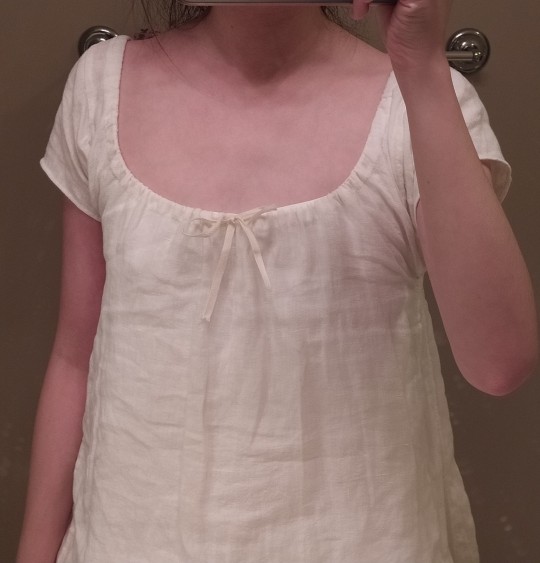
Step 12: Make the gown bodice using the bodice block you drafted months ago. Be completely shocked that it actually fits over the correct silhouette from the new stays. Then be less surprised when you realize it’s adjustable. Make a mental note that the front panels should probably slant down a little more in the future, in order to curve under the bust.
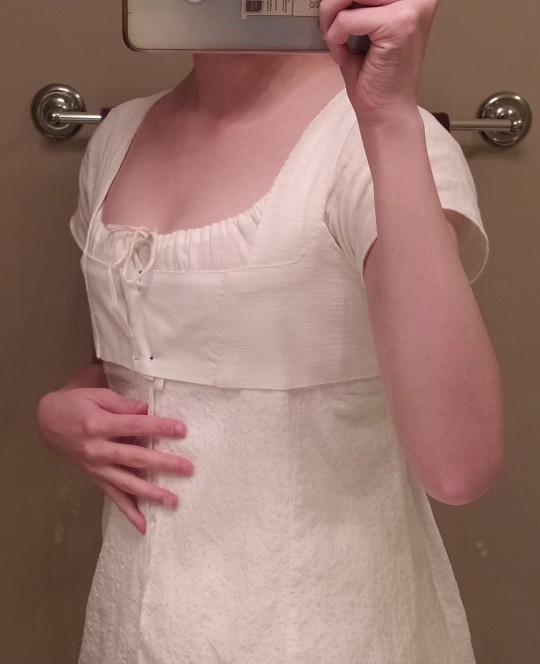
Step 13: Draft a sleeve pattern by completely winging it. Get it right on the first try. Add the sleeves to the bodice. Embroider the gown bodice, because you couldn’t find an appropriately embroidered fabric and resolved to hand-embroider it because who ever wanted to do things the easy way?

Step 14: Add drawstrings to the insides of the sleeves so you can adjust the height and puffiness of them. Cut out the skirt and line the front panel for extra structure. Have a decently good time doing colonial knots on the front skirt panel. Have a decidedly less good time trying to embroider tiny dots on the rest of the skirt, which does not have a lining backing it. Give up halfway through and sew the skirt and bodice to the cotton twill tape that will serve as the backing to the waistband.
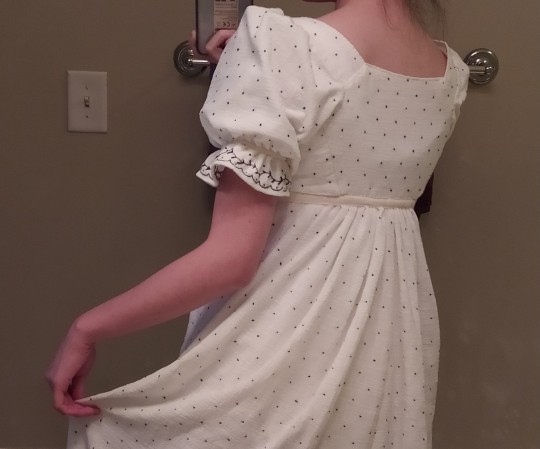
Step 15: Take pictures because it looks pretty from the back, even though the bottom half of the skirt still needs embroidery, and you still haven’t finished the front skirt panel or the bodice front bib or the waistband.
To be continued...
#sewing#hand sewing#regency fashion#historical costuming#tricia sews (kind of)#disclaimer: there is probably nothing historically accurate about the way I constructed this gown#i only hand sew because i don't know how to use a machine#i'm not a dress historian; just a nerd#i chose to use a twill tape waistband because the extant gown doesn't look like the skirt is attached directly to the bodice#but i don't know how they constructed it because we don't get to see the back of the dress#so i'm just making things up by doing things in a way that i hope will improve the longevity of the garment#e.g. i'm choosing to cover and finish all my seams even though they probably left raw edges on the inside back then
10 notes
·
View notes
Text
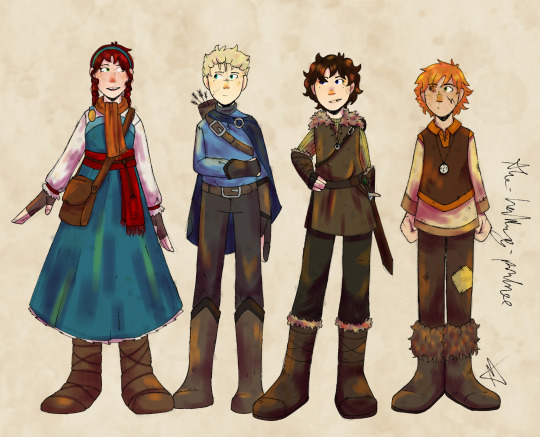
I finally drew this group of my ocs in their winter attire.
Honestly I'm so proud of how much better I've gotten at character design. Like if y'all could see these characters' original designs from when I was 12. They were... very sad.
#Gods i need to redraw all of their original designs one day. Just for fun.#I don't even know what was up with Daliah (girl on the right)'s original design. I need to show y'all it was so weird and bad.#Like obviously these designs are not historically accurate but they are based on historical clothes. The original designs ?#1. Boring. 2. What? 3. Why?#Yeah anyway I really like how these came out#Wait I've had these characters for like... 6 years. I've been writing this damn book. For six years. Fuuuuuuuck#my posts#my art#abe's wip: harlow#harlow series#harlow stormrage#daliah of krowethia#careless crowthorne#tiger bjornson
3 notes
·
View notes
Note
Imaginary Books Recs: Congratulations! You've been granted further ILL access to the Coregean Library. Shall we start with Ardour and Introspection? An early nineteenth-century romance that was a favorite of, of all people, Delclis.

Ardour and Introspection by Giora Shorr
Emina Verden has a passion for plants that her loving father is more than willing to let her pursue, but after his death and her mother's remarriage to a fashionable baronet, Emina is thrown into a high-society world where she is expected to attend balls and concerts and dinner parties while enduring the company of Vivana, her over-exuberant stepsister. As Emina struggles to find a place in this new family--and a moment of peace--a friendship with a young scholar unexpectedly blossoms into something that makes this new world worth exploring. But Vivana is the one who catches his eye--and, perhaps, his heart. Will Vivana keep Emina from her one chance at happiness? Is it possible for the stepsisters to overcome this rivalry, or will it tear them apart forever?
#imaginary book recs#answered asks#the blackberry bushes#isfjmel-phleg#i must once again fall at your feet in gratitude for the interlibrary loan opportunities#coregean literature is a whole new world of delights#i've heard good things about giora shorr and she did not disappoint#just the kind of thing i love#thought tbh a good chunk of my initial interest was curiosity over the fact that this was among king delclis' favorites#not at all the kind of thing i'd expect from him#or so i thought#then i read two (2) pages of this book and was like 'oh i understand'#the plant thing alone would have drawn him in#(though i'd love to know his thoughts about how accurate the science was)#and then the life parallels!#though i see a bit of irony in his love of the book vs his life choices#though of course i don't know enough about the historical details to make very specific comments
22 notes
·
View notes
Text
just watched Alias Grace and, what do you mean the 1840s sucked for women and poor people and Irish immigrants??
no but I srrsly enjoyed it, def recommend it to my fellow kuro victorian era nuts if you want something kind of depressing that will make you feel rage for the female characters, oh and if you want a morally ambiguous female lead who is based off of a real woman who may or may not have been a murderer but was definitely an accomplice to murder, also they call her a murderess in the show which is so slay
#can't tell how accurate the 1840s costumes were since I don't know much about 1840s fashion but I can say there were some good bonnets#which is always a plus#tho they didn't do those face framing curls that I see on fashion plates from the era which is disappointing I feel like period pieces rlly#hate proper historical hair for some reason#like even the wealthier women who would have wanted to keep up with trends didn't have it#it's 4:00 am and I should rlly go to bed now lol#victorian era#historical drama
4 notes
·
View notes
Text
Just learned that my actual ancestor Harald Finehair is in this show. I do hope he's a good character (not morally of course)!
#don't know how they're going to work that one out since harald finehair (according to the legends) was a descendant of ragnar lothbrok#I'm not expecting this show to be historically accurate but I'm curious#this of course makes ragnar my ancestor as well. so nice of them to make a show about my fam!;)#I am watching vikings
9 notes
·
View notes
Text
I just saw a Tik Tok saying that Classical music was essentially made by straight white dudes and someone reacting to that Tik Tok saying that most cultures didn’t write down their music, they just spoke about it. Both are not wrong but also... very wrong. There were plenty of female and colored composers throughout the centuries that composed classical music and I’m pretty sure a good portion of them were not straight. However, they definitely do not get as much credit as Bach or Mozart (who are still great composers in their own right- unless we really want to talk about Mozart overshowing his older sister who was violinist) because of well- the times were a bit racist and sexist.
Nonetheless- there were (and possibly still are) female and colored composers so in spite of these two girls and because I’ve kind of listened out of curiosity to some of these composers a while back, here’s a list of a bunch of female composers and some of people of different ethnicities. If someone well versed in Classical music much more than me wants to add on to anything, feel free.
https://parkersymphony.org/women-composers#:~:text=A%20Look%20At%20Female%20Classical%20Music%20Composers%201,Chaminade%20...%208%20Ethel%20Smyth%20...%20More%20items
https://www.classicfm.com/discover-music/latest/great-women-composers/barbara-strozzi/
https://www.classicfm.com/discover-music/black-composers-who-made-classical-music-history/#:~:text=10%20Black%20composers%20who%20changed%20the%20course%20of,8%20George%20Walker%20%281922%20%E2%80%93%202018%29%20More%20items
https://www.thegilmore.org/blog/composers-of-color-you-should-know/
And also- to that girl that said many cultures didn’t write down their music and instead passed it by word, yes there were many cultures that did that. But we also do still have a lot of written records of music and art that survived to this day or got destroyed by another one or lost to time itself. And there are still cultures that had originally passed on their stories, songs, and art techniques by word of mouth and still do, but many have also gone on to write them down as a means of preservation.
I encourage people to research more into this rather than listen to a white college student ranting from the top of their head what they remember from what little they’ve researched, but I hope this encourages people to look into this stuff more because it’s cool and interesting.
#classical music#rant post#classical composers#I'm trying to be a bit more careful about spewing off historical misinformation#I've been called out a couple times and really don't want to accidentally be in the wrong by any means#my major is art history- I want to be accurate in my facts#I've done minimal study on this so- do your own research#I'm just mad at both sides for basically saying that only white composers exist#girl who said the cultures thing also said that those were the only people 'at the time' who could write#'the time' first of all was about a course of a thousand years. Even if it was uncommon to know how to right based on ethnicity or gender#many people still found ways to write or had the privilege or talent to learn how to write#some weren't able to learn how to write because of sexism and racism#but by at least the late 1700's and early 1800's- when a lot of classical music was composed- learning how to write and compose was common#but basically- no one's getting suppressed if you listen to classical music and there were plenty of different people that composed music
2 notes
·
View notes
Text
A Guide to Historically Accurate Regency-Era Names

I recently received a message from a historical romance writer asking if I knew any good resources for finding historically accurate Regency-era names for their characters.
Not knowing any off the top of my head, I dug around online a bit and found there really isn’t much out there. The vast majority of search results were Buzzfeed-style listicles which range from accurate-adjacent to really, really, really bad.
I did find a few blog posts with fairly decent name lists, but noticed that even these have very little indication as to each name’s relative popularity as those statistical breakdowns really don't exist.
I began writing up a response with this information, but then I (being a research addict who was currently snowed in after a blizzard) thought hey - if there aren’t any good resources out there why not make one myself?
As I lacked any compiled data to work from, I had to do my own data wrangling on this project. Due to this fact, I limited the scope to what I thought would be the most useful for writers who focus on this era, namely - people of a marriageable age living in the wealthiest areas of London.
So with this in mind - I went through period records and compiled the names of 25,000 couples who were married in the City of Westminster (which includes Mayfair, St. James and Hyde Park) between 1804 to 1821.
So let’s see what all that data tells us…
To begin - I think it’s hard for us in the modern world with our wide and varied abundance of first names to conceive of just how POPULAR popular names of the past were.
If you were to take a modern sample of 25-year-old (born in 1998) American women, the most common name would be Emily with 1.35% of the total population. If you were to add the next four most popular names (Hannah, Samantha, Sarah and Ashley) these top five names would bring you to 5.5% of the total population. (source: Social Security Administration)
If you were to do the same survey in Regency London - the most common name would be Mary with 19.2% of the population. Add the next four most popular names (Elizabeth, Ann, Sarah and Jane) and with just 5 names you would have covered 62% of all women.
To hit 62% of the population in the modern survey it would take the top 400 names.
The top five Regency men’s names (John, William, Thomas, James and George) have nearly identical statistics as the women’s names.
I struggled for the better part of a week with how to present my findings, as a big list in alphabetical order really fails to get across the popularity factor and also isn’t the most tumblr-compatible format. And then my YouTube homepage recommended a random video of someone ranking all the books they’d read last year - and so I present…
The Regency Name Popularity Tier List
The Tiers
S+ - 10% of the population or greater. There is no modern equivalent to this level of popularity. 52% of the population had one of these 7 names.
S - 2-10%. There is still no modern equivalent to this level of popularity. Names in this percentage range in the past have included Mary and William in the 1880s and Jennifer in the late 1970s (topped out at 4%).
A - 1-2%. The top five modern names usually fall in this range. Kids with these names would probably include their last initial in class to avoid confusion. (1998 examples: Emily, Sarah, Ashley, Michael, Christopher, Brandon.)
B - .3-1%. Very common names. Would fall in the top 50 modern names. You would most likely know at least 1 person with these names. (1998 examples: Jessica, Megan, Allison, Justin, Ryan, Eric)
C - .17-.3%. Common names. Would fall in the modern top 100. You would probably know someone with these names, or at least know of them. (1998 examples: Chloe, Grace, Vanessa, Sean, Spencer, Seth)
D - .06-.17%. Less common names. In the modern top 250. You may not personally know someone with these names, but you’re aware of them. (1998 examples: Faith, Cassidy, Summer, Griffin, Dustin, Colby)
E - .02-.06%. Uncommon names. You’re aware these are names, but they are not common. Unusual enough they may be remarked upon. (1998 examples: Calista, Skye, Precious, Fabian, Justice, Lorenzo)
F - .01-.02%. Rare names. You may have heard of these names, but you probably don’t know anyone with one. Extremely unusual, and would likely be remarked upon. (1998 examples: Emerald, Lourdes, Serenity, Dario, Tavian, Adonis)
G - Very rare names. There are only a handful of people with these names in the entire country. You’ve never met anyone with this name.
H - Virtually non-existent. Names that theoretically could have existed in the Regency period (their original source pre-dates the early 19th century) but I found fewer than five (and often no) period examples of them being used in Regency England. (Example names taken from romance novels and online Regency name lists.)
Just to once again reinforce how POPULAR popular names were before we get to the tier lists - statistically, in a ballroom of 100 people in Regency London: 80 would have names from tiers S+/S. An additional 15 people would have names from tiers A/B and C. 4 of the remaining 5 would have names from D/E. Only one would have a name from below tier E.
Women's Names
S+ Mary, Elizabeth, Ann, Sarah
S - Jane, Mary Ann+, Hannah, Susannah, Margaret, Catherine, Martha, Charlotte, Maria
A - Frances, Harriet, Sophia, Eleanor, Rebecca
B - Alice, Amelia, Bridget~, Caroline, Eliza, Esther, Isabella, Louisa, Lucy, Lydia, Phoebe, Rachel, Susan
C - Ellen, Fanny*, Grace, Henrietta, Hester, Jemima, Matilda, Priscilla
D - Abigail, Agnes, Amy, Augusta, Barbara, Betsy*, Betty*, Cecilia, Christiana, Clarissa, Deborah, Diana, Dinah, Dorothy, Emily, Emma, Georgiana, Helen, Janet^, Joanna, Johanna, Judith, Julia, Kezia, Kitty*, Letitia, Nancy*, Ruth, Winifred>
E - Arabella, Celia, Charity, Clara, Cordelia, Dorcas, Eve, Georgina, Honor, Honora, Jennet^, Jessie*^, Joan, Joyce, Juliana, Juliet, Lavinia, Leah, Margery, Marian, Marianne, Marie, Mercy, Miriam, Naomi, Patience, Penelope, Philadelphia, Phillis, Prudence, Rhoda, Rosanna, Rose, Rosetta, Rosina, Sabina, Selina, Sylvia, Theodosia, Theresa
F - (selected) Alicia, Bethia, Euphemia, Frederica, Helena, Leonora, Mariana, Millicent, Mirah, Olivia, Philippa, Rosamund, Sybella, Tabitha, Temperance, Theophila, Thomasin, Tryphena, Ursula, Virtue, Wilhelmina
G - (selected) Adelaide, Alethia, Angelina, Cassandra, Cherry, Constance, Delilah, Dorinda, Drusilla, Eva, Happy, Jessica, Josephine, Laura, Minerva, Octavia, Parthenia, Theodora, Violet, Zipporah
H - Alberta, Alexandra, Amber, Ashley, Calliope, Calpurnia, Chloe, Cressida, Cynthia, Daisy, Daphne, Elaine, Eloise, Estella, Lilian, Lilias, Francesca, Gabriella, Genevieve, Gwendoline, Hermione, Hyacinth, Inez, Iris, Kathleen, Madeline, Maude, Melody, Portia, Seabright, Seraphina, Sienna, Verity
Men's Names
S+ John, William, Thomas
S - James, George, Joseph, Richard, Robert, Charles, Henry, Edward, Samuel
A - Benjamin, (Mother’s/Grandmother’s maiden name used as first name)#
B - Alexander^, Andrew, Daniel, David>, Edmund, Francis, Frederick, Isaac, Matthew, Michael, Patrick~, Peter, Philip, Stephen, Timothy
C - Abraham, Anthony, Christopher, Hugh>, Jeremiah, Jonathan, Nathaniel, Walter
D - Adam, Arthur, Bartholomew, Cornelius, Dennis, Evan>, Jacob, Job, Josiah, Joshua, Lawrence, Lewis, Luke, Mark, Martin, Moses, Nicholas, Owen>, Paul, Ralph, Simon
E - Aaron, Alfred, Allen, Ambrose, Amos, Archibald, Augustin, Augustus, Barnard, Barney, Bernard, Bryan, Caleb, Christian, Clement, Colin, Duncan^, Ebenezer, Edwin, Emanuel, Felix, Gabriel, Gerard, Gilbert, Giles, Griffith, Harry*, Herbert, Humphrey, Israel, Jabez, Jesse, Joel, Jonas, Lancelot, Matthias, Maurice, Miles, Oliver, Rees, Reuben, Roger, Rowland, Solomon, Theophilus, Valentine, Zachariah
F - (selected) Abel, Barnabus, Benedict, Connor, Elijah, Ernest, Gideon, Godfrey, Gregory, Hector, Horace, Horatio, Isaiah, Jasper, Levi, Marmaduke, Noah, Percival, Shadrach, Vincent
G - (selected) Albion, Darius, Christmas, Cleophas, Enoch, Ethelbert, Gavin, Griffin, Hercules, Hugo, Innocent, Justin, Maximilian, Methuselah, Peregrine, Phineas, Roland, Sebastian, Sylvester, Theodore, Titus, Zephaniah
H - Albinus, Americus, Cassian, Dominic, Eric, Milo, Rollo, Trevor, Tristan, Waldo, Xavier
# Men were sometimes given a family surname (most often their mother's or grandmother's maiden name) as their first name - the most famous example of this being Fitzwilliam Darcy. If you were to combine all surname-based first names as a single 'name' this is where the practice would rank.
*Rank as a given name, not a nickname
+If you count Mary Ann as a separate name from Mary - Mary would remain in S+ even without the Mary Anns included
~Primarily used by people of Irish descent
^Primarily used by people of Scottish descent
>Primarily used by people of Welsh descent
I was going to continue on and write about why Regency-era first names were so uniform, discuss historically accurate surnames, nicknames, and include a little guide to finding 'unique' names that are still historically accurate - but this post is already very, very long, so that will have to wait for a later date.
If anyone has any questions/comments/clarifications in the meantime feel free to message me.
Methodology notes: All data is from marriage records covering six parishes in the City of Westminster between 1804 and 1821. The total sample size was 50,950 individuals.
I chose marriage records rather than births/baptisms as I wanted to focus on individuals who were adults during the Regency era rather than newborns. I think many people make the mistake when researching historical names by using baby name data for the year their story takes place rather than 20 to 30 years prior, and I wanted to avoid that. If you are writing a story that takes place in 1930 you don’t want to research the top names for 1930, you need to be looking at 1910 or earlier if you are naming adult characters.
I combined (for my own sanity) names that are pronounced identically but have minor spelling differences: i.e. the data for Catherine also includes Catharines and Katherines, Susannah includes Susannas, Phoebe includes Phebes, etc.
The compound 'Mother's/Grandmother's maiden name used as first name' designation is an educated guesstimate based on what I recognized as known surnames, as I do not hate myself enough to go through 25,000+ individuals and confirm their mother's maiden names. So if the tally includes any individuals who just happened to be named Fitzroy/Hastings/Townsend/etc. because their parents liked the sound of it and not due to any familial relations - my bad.
I did a small comparative survey of 5,000 individuals in several rural communities in Rutland and Staffordshire (chosen because they had the cleanest data I could find and I was lazy) to see if there were any significant differences between urban and rural naming practices and found the results to be very similar. The most noticeable difference I observed was that the S+ tier names were even MORE popular in rural areas than in London. In Rutland between 1810 and 1820 Elizabeths comprised 21.4% of all brides vs. 15.3% in the London survey. All other S+ names also saw increases of between 1% and 6%. I also observed that the rural communities I surveyed saw a small, but noticeable and fairly consistent, increase in the use of names with Biblical origins.
Sources of the records I used for my survey:
Ancestry.com. England & Wales Marriages, 1538-1988 [database on-line].
Ancestry.com. Westminster, London, England, Church of England Marriages and Banns, 1754-1935 [database on-line].
#history#regency#1800s#1810s#names#london#writing resources#regency romance#jane austen#bridgerton#bridgerton would be an exponentially better show if daphne's name was dorcas#behold - the reason i haven't posted in three weeks
9K notes
·
View notes